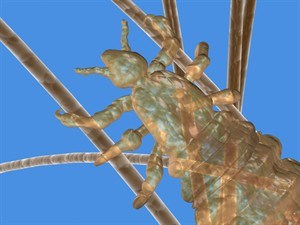
A 3D louse image is shown. THE CANADIAN PRESS/HO
November 08, 2013 - 1:51 AM
Tips for treating head lice from the Centers for Disease Control and Prevention:
— Using an over-the-counter or prescription medicine, follow the instructions printed on the box or label. Hair that is longer than shoulder length may require two bottles. Be sure to note how long the medication should be left on the hair and how it should be washed out.
— Do not use a combination shampoo/conditioner or conditioner alone before using the lice medicine. Refrain from washing the hair for a day or two after the lice medicine is removed.
— Check for live lice eight to 12 hours after treatment. A few lice may survive. If they're moving more slowly than before, do not re-treat. The medicine may take longer to kill all the lice. Comb dead and any remaining live lice out of the hair using a nit comb, which is designed to remove the lice eggs from the hair shaft.
— After eight to 12 hours of treatment, if no dead lice are found and the lice seem as active as before, the medicine may not be working. Consult your health care provider before re-treating. If your health care provider recommends a different treatment, carefully follow the instructions in the box or printed on the label.
— Nit combs, designed to remove lice eggs from the hair shaft, are often found in lice medicine packages. Use the comb to remove the eggs and lice from the hair. Flea combs made for cats and dogs may also be effective.
— After each treatment, checking the hair and combing with a nit comb to remove nits and lice every two to three days may decrease the chance of self-reinfestation. Continue to check for two to three weeks to be sure all lice and nits are gone.
— Retreatment is meant to kill any surviving hatched lice before they produce new eggs. Depending on the drug, retreatment is recommended routinely seven to nine days after the first treatment. For other medications, retreatment is recommended only if crawling lice are seen during this period. Retreatment with lindane shampoo is not recommended.
— Machine wash and dry clothing, bed linens and other items that the infested person wore or used during the two days before treatment using the hot water (130 degrees Fahrenheit) laundry cycle and the high-heat drying cycle. Clothing and items that are not washable can be dry cleaned or sealed in a plastic bag and stored for two weeks.
— Soak combs and brushes in water that is at least 130 F for five to 10 minutes.
— Vacuum the floor and furniture, particularly where the infested person sat or lay. However, the risk of getting infested by a louse that has fallen onto a rug or carpet or furniture is very small. Head lice survive less than one to two days if they fall off a person and cannot feed; nits cannot hatch and usually die within a week if they are not kept at the same temperature as that found close to the human scalp.
— Do not use fumigant sprays; they can be toxic if inhaled or absorbed through the skin.
News from © The Associated Press, 2013